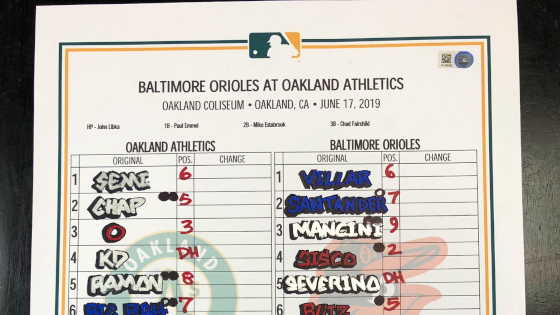
Detail of a lineup card from a June 17, 2019 game between the Oakland Athletics and Baltimore Orioles, as filled out by Athletics coach Ryan Christenson. Christenson has become well-known across several stops for his flair in filling out lineup cards. Original image sourced from OAKAuthentics on Twitter. You can view the entire card without visiting Twitter, here.
Lineups
Before a game, each team presents the list of players who will be starting that game, along with the positions they will be playing, and for offensive players, which side of the plate they will bat from1. This is known as the lineup, and it includes not only the starting players, but also the players who can be called upon in reserve. All of this information goes onto something called the lineup card. Each team gets a copy of the other team’s card, and both teams provide a lineup card to the home plate umpire. The two most important concepts here are the players listed on the roster (a player not listed on the lineup card cannot enter the game), and the batting order. There are no official rules for how a batting order is laid out, but once it is laid out, a player cannot move from one slot in the order to another2. When a player comes off the bench, they go into the lineup slot of the player they are replacing, even if they are not going to play the same position. However, if a defensive player switches positions, they keep their original slot in the lineup3.
There’s a lot of terminology when it comes to a lineup. Some of it is fairly self-evident— for example first three batters are often called the “top” of the lineup, the second three batters are called the “middle” or “heart” of the order, and the last three batters are called the “bottom” of the order. The very first hitter is called the “leadoff” hitter, as they will leadoff the game4. And finally, the fourth batter in the lineup is often referred to as the “cleanup” hitter, on the theory that if the batters ahead of them can get on base, the fourth batter can then “clean up” the bases by batting in those runners.
As a team cycles through its lineup, the player currently at the plate will be said to be “at bat,” while the next batter up will be “on deck.” This means they will be literally on the field, in their team’s on-deck circle. The next batter after them will be “in the hole,” though not actually on the field. Once the plate appearance ends, the on-deck player will come up to bat, the batter in the hole will come out on deck, and so on, until the lineup turns over.